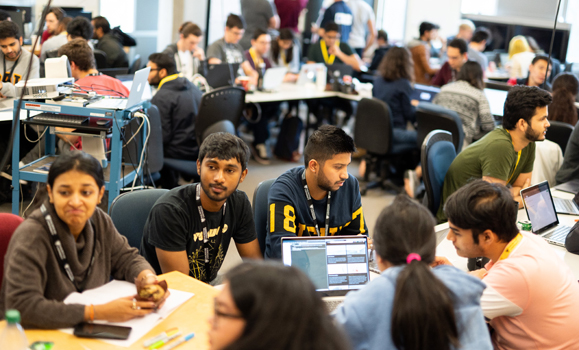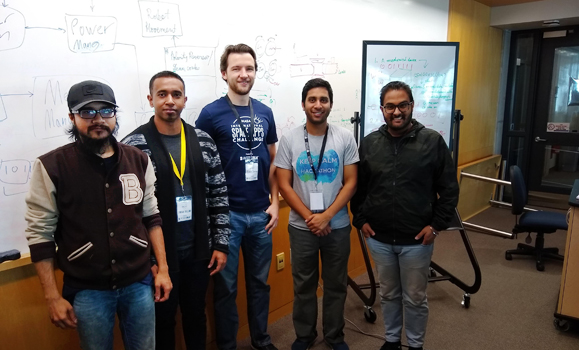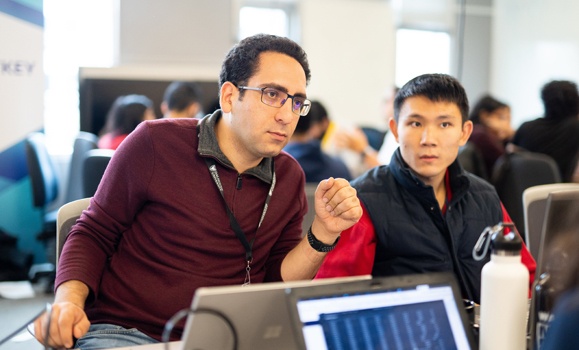Dylan Ormiston and Emran Billah have a complicated challenge on their hands. Theyтve been tasked with developing a device that will allow NASA scientists to collect data from Venus over extended periods of time.
The issue: with its sulfuric acid clouds, temperatures over 450 degree Celsius and extremely high surface pressures, Venus is one of the most hostile planetary environments in the solar system. That means prior missions to the planet have only survived for two hours.
Dylan and Emranтs project is part of the International NASA Space Apps Challenge, a 48-hour hackathon event that simultaneously took place in over 200 cities around the world in late October.
Co-hosted by the аТМгЦТСљКЯВЪПЊНБжБВЅ Emera ideaHUB, аТМгЦТСљКЯВЪПЊНБжБВЅ Space Systems Labs, SuperNova and Shiftkeys Labs, the event marked the first time аТМгЦТСљКЯВЪПЊНБжБВЅ has competed in the NASA Space Apps Challenge.
With its unique appeal to the Atlantic region, the event drew in a number of key sponsors including Intertalk Critical Information Systems, MDA and Lixar IT.
Hackathon т engage!
Sixty participants from across the Maritimes gathered at Shitkeys Labs in the Faculty of Computer Science to take part in the coding fest.Ь§
The hackathon brought programmers, scientists, designers, storytellers, builders and technologist together to solve real-world problems with innovative solutions.

Teams of five were assigned challenges developed by NASA or the Canadian Space Agency (CSA), many centered around data analysis and finding solutions to problems related to space and earth.
And while some may associate hackathon events with computer programming, a number of participants from Dalтs Faculty of Engineering were instantly drawn to this weekendтs competition.
Spaced out
Dylan, a fourth-year Mechanical Engineering student, and Emran, a recent graduate of Dalтs Department of Electrical and Computer Engineering, are also members of the аТМгЦТСљКЯВЪПЊНБжБВЅ Space Systems team т a group dedicated to space exploration.
A Star Wars junkie growing up, Dylan says the chance to work with NASA and CSA was an opportunity he couldnтt miss.
тSpace is so mysterious, so foreign, so alien. From an engineering standpoint, when it comes to space, you only have one shot at solving a problem and there are so many different factors you have to consider when designing something,т he says.
Finding an innovative way to collect and return valuable long-term science data from Venus wasnтt an easy task. Especially on a tight deadline.
Collaborating their efforts and diverse backgrounds, Dylan and Emran teamed up with two students from the Faculty of Computer Science and one from the Faculty of Management.
 Ь§
Ь§
тWhen we were working together we could really see how many different ideas came together just because of that,т says Emran. тWe werenтt quite limited or cornered to thinking one way.т
Keeping it interdisciplinary
In conducting their research, they discovered that given Venusт high pressure and temperatures, conventional rovers would melt within minutes of landing on the planet. That combined with electromagnetic disturbances of waves with frequencies of more than 700 Hz, make the use of traditional electromagnetic devices redundant in the environment.
тThat gave us an idea of the type of approach we needed to take. We knew we had to go back to old school style memory systems made of majorly mechanical parts and simple analog electronics and thatтs where the ideation process started,т says Emran.
With a number of industry members on hand to judge and mentor participants at the event, the team was able to engage with CSA scientists to get advice and feedback on the validity of their design.
What they came up with was a project inspired by a Rubikтs cube in which different components of the cube could be manipulated mechanically to store a different data value.
тWhat that means is that the number of input combinations that can be achieved with this design could meet and surpass the 1MB of storage that was required in the challenge,т says Dylan. тThat objective was the big selling point for the challenge.т
The second part of the challenge was designing a power reversing system, one that was inspired by a traditional reverse gear shift similar to an automobile transmission. Dylan adds that the opportunity to showcase his engineering skills in the hackathon, and to learn from participants in other disciplines was a driving force in competing in the competition.
Exploring entrepreneurial opportunities
Across the room, Reza Rahimi and his sister Fatemeh Rahimi huddled around a Surface Pro contemplating how to assist Canadian scientists in protecting the population from solar flares. The siblings hoped to find a way to improve geomagnetic data sets essential in monitoring the earthтs magnetic field
For Reza, the chance to compete in this weekendтs event was an opportunity to showcase the versatility of his engineering degree and explore his entrepreneurial spirit.
A fourth-year PhD student in Dalтs Department of Civil Engineering, his recent thesis research helped prepare him for the hackathon.
тMy thesis was about accelerating an engineering software and included a lot of coding and programming,т he says.
Heтs also in the process of launching his own business venture, developing a unique engineering software product that he hopes to soon commercialize in Canada.
Having already taken part in Dalтs Collide Program and Launchpad Accelerator, courses geared towards students interested in hatching entrepreneurial opportunities, Reza says this weekend he was able to put the skills heтs learned to the test.
тI want to show a part of the product Iтm creating in this hackathon. I want to use what Iтve learned building software for engineers,т he says. тThat was my goal, to see if I can incorporate what Iтve learned during my PhD into this hackathon.т
Partnering with his sister, a second-year masterтs student in Dalтs Computer Science program, and three other students also from the Faculty of Computer Science, Reza says each participant had a vital role to play in solving their space apps challenge. For him, that meant tackling the software optimization of their application.
He says he wishes more hackathons such as the NASA Space Apps challenges would take place in Halifax, exposing participants to not only the mysteries of space, but the world of entrepreneurial opportunities.
тWe need entrepreneurs in Canada, we need people who take risks and start big things. I believe that Canada is the new Silicon Valley. I think we have the potential and we just need to teach people how to be entrepreneurs and help them go down this path.т

